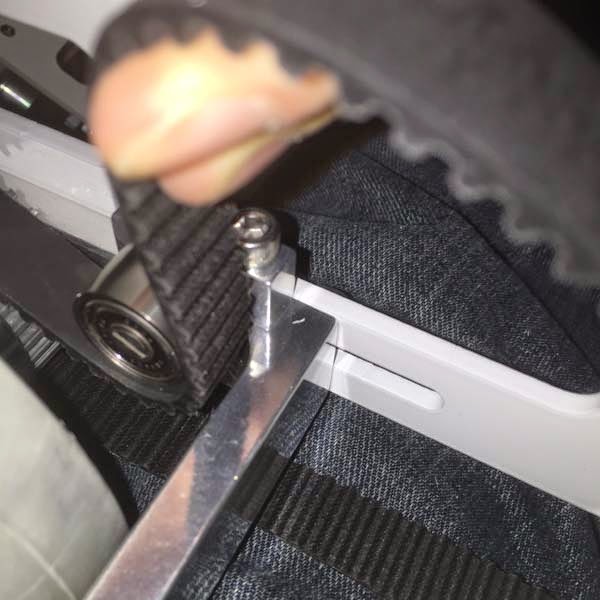The kit is very complete and his step by step instructions on the forum are pretty much spot on. I did run across a few stumbles, which I hope this blog with clarify for other builders getting ready to put theirs together!
The structure that holds the arms is called the "Utility Arm Carrier" and consists of the side pieces and horizontal ones. The arms are held in place in there with a shaft, secured with spacers that sit in shallow holes in the horizontal pieces.
With this kit, those spacers are replaced with pulleys and belts, driven by servo motors.
First the horizontal pieces need to have the holes widened The recess will stay but the hole needs to have a 3/8 inch drill bit widen the hole. The allows for the bearing to fit inside.
I used an R2-D2 toy as a reference, so I would recall where the pivot point was for each arm. For example, the top one pivots opposite the bottom. I even labeled the horizontal pieces so I would know which was which. In the picture, I have "Bot Top" and "BB" (Bottom Bottom) to indicate they are for the lower arm. On the left you can see "TT" (Top Top) and TB (Top Bottom) written on the pieces. While not necessary, I did it to help maintain order.
Now on to the Utility Arms, which I recently cleaned up and beadblast the Dykem off of.
First, a hole has to be drilled, then tapped, so that a set screw can thread in and ensure a tight fit for the pivot shaft. The set screw is 6/32 so the hole will be pretty tiny! With the utility arm being curved, I will have to use the hand drill and vice to drill the hole.
I use the hole punch tool so that I have a divot to drill into. This prevents the drill tip from wandering. Even more important since the area we are drilling is curved and we need a good, straight hole into the pivot hole.
Now on to the pivot shafts.
Mine went on extremely tight, I didn't need to sand them...but I did use the vice so I could lightly tap the shaft into place, making sure the flat side faces where the set screw will be.
Once they are in, you need to find an extremely tiny metric allen wrench for the set screws to be screwed into position.
Then, on to the pulleys. I put the wrong ones on (as you will see in the next few photos), so be sure you are putting these on....
 |
| These go on the Utility Arms! The other cogs will go to the motor |
And (again wrong pulley in the picture), you line the set screw to flat side of the pivot shift to secure it. Each pulley has two holes for set screws, I put one in each. I also used a mini vice and a small hammer to center the shaft as needed before tightening the set screws
Now, time to piece together the Utility Arm Carrier while adding some new mounting pieces.
I found by putting the top and bottom pieces on, then loosely attaching the back plate worked best. You'll find you need to really squeeze the back plate at times to get holes to line up.
 |
| Notice the widened hole on the lower left, which, looking at the R2 statue, matches where the pivot piece is |
Next, the frame mounting brackets go on. As a reference, this picture from Rotopod's instructions reminds you which one is mounted higher than the other.
To attach the mounting brackets, you wind up doing some delicate swapping around of the machine screws. What was holding a piece on gets removed, then put back on with the mounting bracket.
Now its time to see how well the utility arms fit. Shims are included, as needed...and many had to sand theirs down considerably. With them in, I couldn't screw the horizontal piece back in. Too thick, need to sand them down thinner.
...so I decided to improvise and drill 0.25 inch holes in some plastic packaging, cut it out into the shape of the shims and install.
...and everything fits. I am able to screw everything back together and the arms move freely with so friction/rubbing. Furthermore, the arms are straight and not sagging.
Right now, I am awaiting the arrival of the servo motors for the next few steps...more in a day or two!



















































